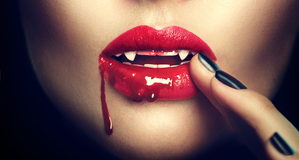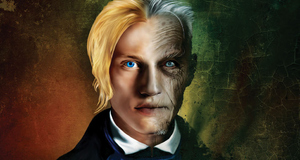Bram Stoker's Dracula: A Reflection and Rebuke of Victorian Society
By
2010, Vol. 2 No. 02 | pg. 2/2 | « A much more recent event which was a strong influence on Stoker’s mixed portrayal on the good and evils of sensual behavior was the prosecution of dear friend and fellow writer, Oscar Wilde, for being accused of participating in homosexual endeavors. It is safe to say that because of his past “intimate history” (Pektas 6) with Wilde, this occurrence greatly contributed to Stoker’s negative portrayal of sex as evil and counterproductive. Stoker himself had “established himself as an open member (of the) homosexual culture” (Pektas 6), and therefore “(Oscar’s) trial made Stoker feel guilty” (7) and loathe his very own sexuality itself, as he could do absolutely nothing to help his dear friend of 20 years but “(to) watch” (Pektas 7). In order to “relieve” his conscience, he suppressed his very own sexuality, and bean writing Dracula about a month after Wilde was convicted of sodomy in 1895. Living “between writing and silence” as a result of being helplessly despairing and unable to help Wilde “(the) result was a text which described Wilde in a diffused and hidden way” (Pektas 7). It seems as though it is almost a sort of underlying “tribute” to Wilde and the homosexual community itself, secretly condemning the “strictly heterosexual” society for their harsh standards and limiting expectations. Though, as a result of constantly being forced to suppress his feelings towards men, the strain and stress of watching a dear and very “close” friend being prosecuted must have caused many of the internally conflicting emotions which led Stoker to personally view (and portray) any sexuality as a vile and painful source of evil and despair. Nilifer Pektas of Soderton University College concludes the following: “The publicity and hostility surrounding the event itself must have affected Stoker, [Dracula] shows Stoker’s suspicions and anxiety towards all forms of sexuality, especially towards those considered to be ‘perverse’…(the) sinful attractions of the Count suggest Stoker’s fears about his own sexuality.” (Pektas 7) Thus, the underlying homoerotic connections (such as blood being representative of semen) are most likely a direct result of Stoker’s own fear and loathing of the brutal society which forced him to internalize his own sexuality, justifying the evils of homosexuality mostly with references to the Christian belief. “Dracula is Stoker’s striving for expressing a culturally repressed homosexual identity” (Auerbach 7; Antonnen 4) as a result of the bias and hatred expressed towards homosexual males in the later 19th-early 20th centuries. Though Dracula seems to be inadvertently portrayed as a reflection of Stoker’s suppressed homosexual identity, at some points the character is also represented as a dominant, forceful, male heterosexual; magnified to an extreme and exaggerating various characteristics of expectations set for a typical Victorian male role. Seemingly a jab at the imperfections of a society whom deemed themselves to be “perfect”, Stoker makes quite a few valid points concerning the unrealistic ideals of Victorian society, making a mockery of them by portraying heterosexuality as equally “vile” and “evil”; as people viewed homosexuality in real life.Insinuating a false love between men and women, Stoker uses the character of Lucy (when she has become a vampire) to portray this concept in a scene when Arthur (Lucy’s fiancé) meets her, for the first time since she had become a vampires. “She still advanced, however, and with a languorous, voluptuous grace, said-‘Come to me, Arthur. Leave these others and come to me. My arms are hungry for you. Come and we can rest together. Come, my husband, come!’ There was something diabolically sweet in her tones- something of the tingling of glass when struck-which rang through the brains even of us who heard the words addressed to another. As for Arthur, he seemed under a spell…” (Stoker 240) This particular passage definitely makes apparent the underlying evils and maliciousness concealed by false love and forced emotion. Though it is not truly Lucy, but a mere imitation of what was once a sweet and good woman, Arthur falls for the deceitful counterfeit, mistaking the evil beckoning for the call of his one true love. The theme of this event seems to be insinuating that, though heterosexual love and marriage was “outwardly” normal and “pure”, beneath the surface was a false love forged by pressure, limited self-expression, and the biased opinions of a strict and confining society. When taking the blood from females (specifically those already claimed by other men), Dracula most notably takes on the exaggerated “male dominance” persona, as previously discerned. The use of such extreme intentional force upon the “weaker” features of susceptible women can constitute as a form of rape, an equally (if not more so) despicable act as homosexually, even though it is a heterosexual inclination. Dracula is portrayed as having an insatiable thirst for blood and power (lust and sex) and is constantly using his intense powers (male dominance and superiority over women) to fulfill his desires, regardless of the well-being of others. He is “a threat to Victorian women such as Mina and (she) becomes victim (only) by force” which can be: interpreted as rape” (Pektas 14). Mina’s emotional portrayal of violation after being “penetrated” by the Count are very similar to those that would be reflected by a rape victim. The scenario which caused such strong and helpless feelings is also representatively played out like a rape scene itself: “With his left hand, he held both Mrs. Harker’s hands, keeping them away with her arms at full tension; his right hand gripped the back of her neck, forcing her facedown on his bosom. Her white night dress was smeared with blood, and a thin stream trickled down the man’s bare breast which was shone by hi torn-open dress.” (Stoker 319) A repulsive depiction of a man holding a woman hostage, “forcing” her to do as he wants, this is most definitely one of the most suggestively insinuative scenes relating to the concept of rape and sexual violation. The Count “forcibly” exchanging blood (bodily fluids) with Mina combined with the sexual symbolism of the blood itself forms an exaggerated portrayal of how men in the Victorian era attempted to force emotional (and physical) bonds with women, often through sexual intercourse. Alongside the heterosexual insinuations are also the homosexual representations, as well. Again, the sexual references are “not directly expressed but (are) expressed through blood, where blood (transfusion) indicates sexual intercourse” (Pektas 11), so when Dracula exchanges blood with man (or an exchange occurs between men themselves), it can be associated with some form of homosexual act in which blood is the substitute for spermatic fluids. Apart from the homosexually-insinuative activities, Dracula also seems to possess some homoerotic emotions when experiencing pleasure, which become apparent at intimate moments with other men. “Dracula’s (exhilaration) at the sight of a man’s blood” (Pektas 18) seems very indicative of homosexual arousal. The best representation of homoerotic symbolism is when Lucy requires a blood transfusion, resulting in the participation of four different men: “‘I take it both you and Van Helsing had done already what I did today? Is not that so?’…’ (And) I guess Art was in on it too… (Then) I guess, Jack Seward, that that poor, pretty creature that we all love has had put into her veins the blood of four strong men.” (Stoker 174-175) The description of the blood transfusions themselves seems to emphasize the “connection” and participation of all four men, focusing on the blood of each individual becoming unified in one body. Even when recalling the affair in conversation between participants, the action is merely referenced without speaking of any specifics, making it seem as though the affair was something indecent, forbidden, and therefore not to be openly discussed in public; very much how one would expect homosexuals to discreetly discuss their affairs between one another in Victorian society. Portraying another exaggeration of the Victorian heterosexual male, Stoker openly alludes to the Counts participation in bigotry, extenuating the “power of men over a woman’s body during the Victorian time” (Pektas 12) and the Victorian belief that “women (are helpless) creatures who are either seduced and penetrated or deluded” by a “masculine ideal” (Pektas 5). The three women whom Dracula seems to keep in his castle are presumably his “brides” and/or “mistresses”. As they are vampires themselves, they have obviously already been “penetrated” and exchanged blood (symbolic of having been deflowered) with the Count. He openly displays his dominance over the three seductresses (referencing the forcibly patriarchal traditions bias) via physical superiority, playing off the common belief that women were the inferior sex as they were physically weaker than their male counterparts, “With a fierce sweep of his arm, he hurled the woman from him, and then motioned to the others as though he were beating them back; it was the very same imperious gesture that I had seen used to the wolves.” (Stoker 50-51) Not only does the Count demonstrate physical dominance, but also intellectual superiority as well; he has the women ”trained” in such a manner that the narrator of the passage compares it to the domestication of animals (the wolves). The women seem to have a dependant relationship with Dracula, again, perfectly imitating the expectations of a forcefully male-dominated society, and recognizing the fact that women have a scarce quantity of rights available to them as opposed to the liberated Caucasian male. “How dare you touch him? Any of you! How dare you cast eyes upon him when I had forbidden it? Back, I tell you all! Beware how you meddle with him, or you shall have to deal with me!” (Stoker 51) When the women obeyed and were openly denied the “right” of access to the Count’s guest, Dracula carelessly tosses the women a “bag”, presumably containing their “meal” for the night, as a symbolic gesture of how desperately dependant women are upon “man”. They were then said to have “closed around” (Stoker 51) the mediocre gift in a very barbaric and animalistic fashion, as though it were of great value (though it clearly meant nothing to the Count himself). One can view this particular incident as Stoker’s attempt to mock just how “needy” society made women out to be, and how unjustly excessive the control was granted to the heterosexual white male. Serving as Bram Stoker’s release of sexual frustration and despair in a time when it was suppressed, Dracula contains references to the behaviors known (in his day) as the three “chief” sexual perversions: the sexually active woman, the rapist (an exaggeration of an “excessively powerful” and “dominant” male figure), and, most prominently, the homosexual male. Whether in honor of his dear friend, Oscar Wilde, or an act of pure rebellion set to shock those who forced him to suppress his nature, the many underlying sexual references and connotations were undoubtedly placed to purposefully defy the common beliefs of the 19th century. “Hidden from the literary censors of the day” (Pektas 7), yet existing, nonetheless, was Stoker’s message silently protesting the smothering expectations of an overly confining and limiting society, right beneath their very noses. ReferencesAntonnen, Romona. “The Savage and the Gentleman; a Comparative Analysis of Two Vampire Characters in Bram Stoker’s Dracula and Anne Rice’s The Vampire Lestat”. Vaxjo University: School of Humanities. Autumn 2000. February 2008 Bohn, Michelle L. “Shadow of the Vampire: Understanding the Transformations of an Icon in Pop Culture”. Texas State University College; Mitte Honors Program. 2007. February 2008. Craft, Christopher. “Kiss Me with Those Red Lips; Gender and Inversion in Bram Stoker’s Dracula”. Bram Stoker. Dracula. Ed. Glennis Byron. New York: MacMillian, 1999. Levin, Judith. The Victorians. Missouri: Andrews and McMeel, 1996. Pektas, Nilifer. “The Importance of Blood During the Victorian Era: Blood as a Sexual Signifier in Bram Stoker’s Dracula”. Soderton University Colleges English Department. Autumn 2005. February 2008. Stoker, Bram. Dracula: New York: Archibald Constable and Company, 1897. Suggested Reading from Inquiries Journal
Inquiries Journal provides undergraduate and graduate students around the world a platform for the wide dissemination of academic work over a range of core disciplines. Representing the work of students from hundreds of institutions around the globe, Inquiries Journal's large database of academic articles is completely free. Learn more | Blog | Submit Latest in Literature |


















